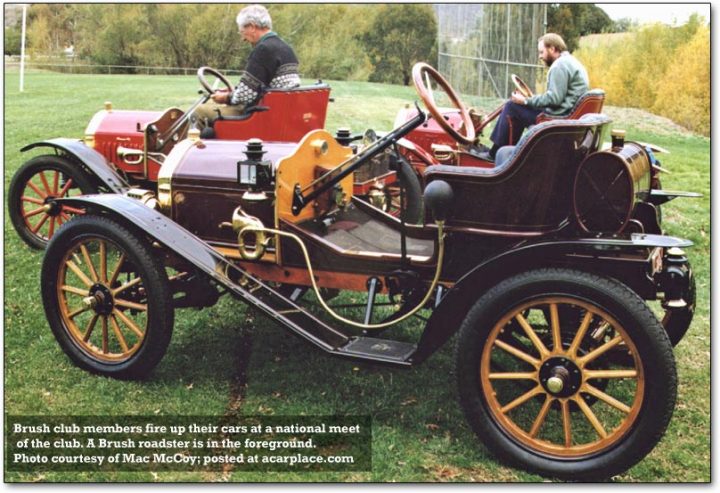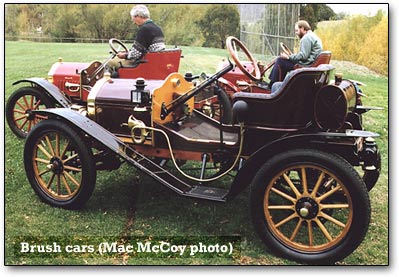
The new standard for pickup automatics is having eight to ten speeds in their automatic transmissions; but one of the foremost engineering innovators for fledging General Motors beat Toyota by about one hundred years. While he was at it, he also introduced some suspension ideas that would become commonplace.
Alanson Brush was a respected technical innovator, despite having any formal mechanical training. He worked for Leland and Falconer Manufacturing in Detroit, following service in the Spanish-American War. That’s how he came to the attention of Henry Leland, who needed some key problems solved related to the drive trains of the first Oldsmobiles. That led to the founders of General Motors also seeking Brush’s advice on the Cadillac and Buick. He also did work for Oakland and Marmon.

Brush had become the chief engineer at Cadillac by 1905; but in October 1905, Brush left the Cadillac Company to start an experimental laboratory and private shop.
Brush established the Brush Runabout Company in Detroit in December 1906. The first Brush automobile was the 1907 Model “A” runabout. The design of the Brush was straightforward with axles and frames fashioned from oak, hickory and maple woods. A six-horsepower, single-cylinder engine powered it; and the Brush was capable of speeds up to 35 miles per hour. It used solid tires and the price was set at $500.
The 1907 model “A” had no transmission; instead, it used a variable speed clutch that gave 8 forward speeds and reverse. At high speeds, it simply became a friction clutch. But it was not well liked by those who desired the simplicity of a conventional planetary transmission.
The Brush was the first production automobile to use coil springs and shock absorbers. It used Hartford friction shocks that did double-duty as locating arms for the suspension; the Brush had ball joints on the bottom of the spring linkage that attached to the axles.
By late 1907, Brush model “B” had replaced the problematic friction drive with a more elementary two-speed planetary transmission, of which there were three types – all basically the same. Pneumatic tires were offered as an option.
By October 1909, the Brush (model “D”) had grown to an 80-inch wheelbase with a 10 horsepower engine. While most were runabouts, some were coupes and a select few were roadsters.
Tom Sumner, owner of Golden Era Motors in Seattle, Washington and member 258 of the Brush Owners Association, owns a 1910 Brush roadster. Sumner acquired his Brush from a guy to whom he sold a Rolls Royce.
The Brush owners’ database shows 14 roadsters, according to Mac McCoy, editor of the club newsletter. The hood is longer on the roadster, the fender line is different, and you sit farther back.

“The engine rotated counter clock-wise. That way, you wouldn’t break your arm, if the spark was in the wrong spot,” explained Sumner, adding, “The hand crank has a spring-loaded device, so it would pop straight-up, if such occurred, so it won’t get you.”
The Brush rides more comfortably than most cars of its time, thanks to the coil springs. Steering wheel feel is deliberate and the mechanical brakes stop it after an indeterminate amount of time.
The 1910 Brush had a dual ignition, with both a magneto and a battery. Its 62.5 cubic-inch engine connects to the rear-end via two chains – unusual for its price point, according to Sumner who explained, “Double-chains were usually big car stuff.”
It was the “big cars” that the Brush was designed to compete against in its day. A Brush Runabout finished the 2,636-mile Glidden Tour in 1909; another climbed Pikes Peak in 8 hours. The lightweight Brush was touted as being able to perform hill climbs like a “squirrel can climb a tree better than an elephant” according to contemporary ads. It also allowed the two-seater Brush to become one of the most popular American cars of its type. Additionally, a Brush was driven across America at a time when that was an achievement in itself.
Unfortunately, Alanson Brush was backed by Frank Briscoe, whose older brother Benjamin had plans to compete with the fledging General Motors. The Brush Runabout Company was absorbed into Briscoe’s U.S. Motor Company in 1910 and died with U.S. Motors’ collapse. The last Brush automobiles – by then with an 80 inch wheelbase and called the Model F — were built in 1911, and continued to be sold into 1912; in that year, the salesman’s art allowed the sale of a “new” Brush: the Liberty — simply the old Brush, reduced to its essentials and offered at the rock bottom price of just $350.

Leave a Reply